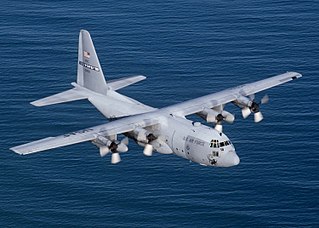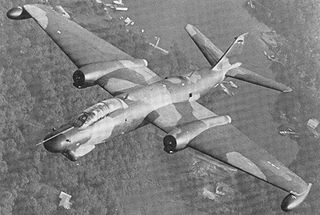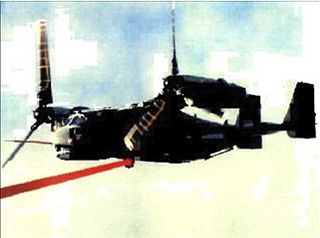
The Lockheed AC-130 gunship is a heavily armed, long-endurance, ground-attack variant of the C-130 Hercules transport, fixed-wing aircraft. It carries a wide array of ground-attack weapons that are integrated with sophisticated sensors, navigation, and fire-control systems. Unlike other modern military fixed-wing aircraft, the AC-130 relies on visual targeting. Since its large profile and low operating altitudes around 7,000 feet make it an easy target, its close air support missions are usually flown at night.

The Lockheed C-130 Hercules is an American four-engine turboprop military transport aircraft designed and built by Lockheed. Capable of using unprepared runways for takeoffs and landings, the C-130 was originally designed as a troop, medevac, and cargo transport aircraft. The versatile airframe has found uses in other roles, including as a gunship (AC-130), for airborne assault, search and rescue, scientific research support, weather reconnaissance, aerial refueling, maritime patrol, and aerial firefighting. It is now the main tactical airlifter for many military forces worldwide. More than 40 variants of the Hercules, including civilian versions marketed as the Lockheed L-100, operate in more than 60 nations.

The Tactical High-Energy Laser, or THEL, was a laser developed for military use, also known as the Nautilus laser system. The mobile version is the Mobile Tactical High-Energy Laser, or MTHEL. In 1996, the United States and Israel entered into an agreement to produce a cooperative THEL called the Demonstrator, which would utilize deuterium fluoride chemical laser technologies. In 2000 and 2001, THEL shot down 28 Katyusha artillery rockets and five artillery shells. On November 4, 2002, THEL shot down an incoming artillery shell. The prototype weapon was roughly the size of six city buses, made up of modules that held a command center, radar and a telescope for tracking targets, the chemical laser itself, fuel and reagent tanks, and a rotating mirror to reflect its beam toward speeding targets. It was discontinued in 2005.

The Boeing YAL-1 airborne laser testbed was a modified Boeing 747-400F with a megawatt-class chemical oxygen iodine laser (COIL) mounted inside. It was primarily designed to test its feasibility as a missile defense system to destroy tactical ballistic missiles (TBMs) while in boost phase. The aircraft was designated YAL-1A in 2004 by the U.S. Department of Defense.

The McDonnell DouglasF-15E Strike Eagle is an American all-weather multirole strike fighter derived from the McDonnell Douglas F-15 Eagle. The F-15E was designed in the 1980s for long-range, high-speed interdiction without relying on escort or electronic-warfare aircraft. United States Air Force (USAF) F-15E Strike Eagles can be generally distinguished from other US Eagle variants by darker aircraft camouflage, conformal fuel tanks (CFTs) mounted along the engine intake ramps and a tandem-seat cockpit.

Kirtland Air Force Base is a United States Air Force base. It is located in the southeast quadrant of the Albuquerque, New Mexico, urban area, adjacent to the Albuquerque International Sunport. The base was named for the early Army aviator Col. Roy C. Kirtland. The military and the international airport share the same runways, making ABQ a joint civil-military airport.

The Air Force Research Laboratory (AFRL) is a scientific research and development detachment of the United States Air Force Materiel Command dedicated to leading the discovery, development, and integration of direct-energy based aerospace warfighting technologies, planning and executing the Air Force science and technology program, and providing warfighting capabilities to United States air, space, and cyberspace forces. It controls the entire Air Force science and technology research budget which was $2.4 billion in 2006.

The Lockheed DC-130 is a variant of the C-130 Hercules modified for drone control. It can carry four Ryan Firebee drones underneath its wings.
The High Energy Liquid Laser Area Defense System (HELLADS), is a counter-RAM system under development that will use a powerful (150 kW) laser to shoot down rockets, missiles, artillery and mortar shells. The initial system will be demonstrated from a static ground-based installation, but in order to eventually be integrated on an aircraft, the final design would require a maximum weight of 750 kg (1,650 lb) and a maximum envelope of 2 cubic meters (70.6 feet3).

A chemical oxygen iodine laser (COIL) is a near–infrared chemical laser. As the beam is infrared, it cannot be seen with the naked eye. It is capable of output power scaling up to megawatts in continuous mode. Its output wavelength is 1315 nm, a transition wavelength of atomic iodine.
A chemical laser is a laser that obtains its energy from a chemical reaction. Chemical lasers can reach continuous wave output with power reaching to megawatt levels. They are used in industry for cutting and drilling.
An airborne laser (ABL) is a laser system operated from a flying platform, as in the:

A laser weapon is a type of directed-energy weapon that uses lasers to inflict damage. Despite decades of research and development, as of 2023, directed-energy weapons, including lasers, remain at the experimental stage. Whether they will be deployed as practical, high-performance military weapons remains to be seen. One of the major issues with laser weapons is atmospheric thermal blooming, which is still largely unsolved. This issue is exacerbated when there is fog, smoke, dust, rain, snow, smog, foam, or purposely dispersed obscurant chemicals present. In essence, a laser generates a beam of light that requires clear air or a vacuum to operate.

The Boeing NC-135 and NKC-135 are special versions of the Boeing C-135 Stratolifter and Boeing KC-135 Stratotanker modified to operate on several different programs.
North Oscura Peak, is a summit in the Oscura Mountains in Socorro County, New Mexico is the location of an Air Force Research Laboratory (AFRL) site in the northern portion of the White Sands Missile Range. It rises to an elevation of 7,976 feet.
List of abbreviations, acronyms and initials related to military subjects such as modern armour, artillery, infantry, and weapons, along with their definitions.

Operation Shed Light was a crash development project in aerial warfare, initiated in 1966 by the United States Air Force to increase the ability to accurately strike at night or in adverse weather. During the 1960s the United States military worked hard to interdict the movement of men and materiel along the Ho Chi Minh trail. The North Vietnamese were experts in the use of weather and darkness to conceal their movement, and understanding the superiority of American air power put their skills immediately to good use. US forces seeking to impede the steady flow of supplies attempted to locate largely static targets during the day with poor results.

The 417th Flight Test Squadron is an active United States Air Force squadron. It is assigned to the 96th Operations Group at Eglin Air Force Base, Florida, where it was reactivated on 17 April 2019.

The Lockheed MartinKC-130 is a family of the extended-range tanker version of the C-130 Hercules transport aircraft. The KC-130J is the latest variant operated by the United States Marine Corps (USMC), with 48 delivered out of 79 ordered. It replaced older KC-130F, KC-130R, and KC-130T variants for aerial refueling. USMC reserve unit, VMGR-452 operated 12 KC-130T aircraft until May 2021; this was the last USMC reserve unit that operated the legacy KC-130s, completing the corps' transition to the more advanced Super Hercules.

The Precision Airborne Standoff Directed Energy Weapon was a weapons system described in unclassified documents leaked to Wired magazine in 2007.














